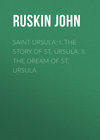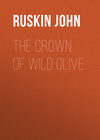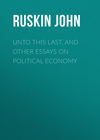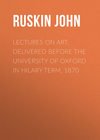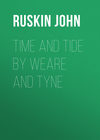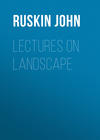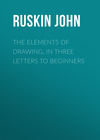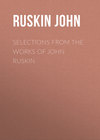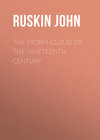Buch lesen: «On the Old Road Vol. 1 (of 2)», Seite 25
101. The introduction of furniture of Art into households of this latter class is now taking place rapidly; and, of course, by the usual system of the ingenious English practical mind, will take place under the general law of supply and demand; that is to say, that whatever a class of consumers, entirely unacquainted with the different qualities of the article they are buying, choose to ask for, will be duly supplied to them by the trade. I observe that this beautiful system is gradually extending lower and lower in education; and that children, like grown-up persons, are more and more able to obtain their toys without any reference to what is useful or useless, or right or wrong; but on the great horseleech's law of "demand and supply." And, indeed, I write these papers, knowing well how effectless all speculations on abstract proprieties or possibilities must be in the present ravening state of national desire for excitement; but the tracing of moral or of mathematical law brings its own quiet reward; though it may be, for the time, impossible to apply either to use.
The power of the new influences which have been brought to bear on the middle-class mind, with respect to Art, may be sufficiently seen in the great rise in the price of pictures which has taken place (principally during the last twenty years) owing to the interest occasioned by national exhibitions, coupled with facilities of carriage, stimulating the activity of dealers, and the collateral discovery by mercantile men that pictures are not a bad investment.
102. The following copy of a document in my own possession will give us a sufficiently accurate standard of Art-price at the date of it:—
"London, June 11th, 1814.
"Received of Mr. Cooke the sum of twenty-two pounds ten shillings for three drawings, viz., Lyme, Land's End, and Poole.
"£22, 10s.
"J. M. W. Turner."
It would be a very pleasant surprise to me if any one of these three (southern coast) drawings, for which the artist received seven guineas each (the odd nine shillings being, I suppose, for the great resource of tale-tellers about Turner—"coach-hire") were now offered to me by any dealer for a hundred. The rise is somewhat greater in the instance of Turner than of any other unpopular81 artist; but it is at least three hundred per cent. on all work by artists of established reputation, whether the public can themselves see anything in it, or not. A certain quantity of intelligent interest mixes, of course, with the mere fever of desire for novelty; and the excellent book illustrations, which are the special subjects of our inquiry, are peculiarly adapted to meet this; for there are at least twenty people who know a good engraving or wood-cut, for one who knows a good picture. The best book illustrations fall into three main classes: fine line engravings (always grave in purpose), typically represented by Goodall's illustrations to Rogers's poems;—fine wood-cuts, or etchings, grave in purpose, such as those by Dalziel, from Thomson and Gilbert;—and fine wood-cuts, or etchings, for purpose of caricature, such as Leech's and Tenniel's in Punch. Each of these have a possibly instructive power special to them, which we will endeavor severally to examine in the next chapter.
Chapter IX. 82
103. I purpose in this chapter, as intimated in the last, to sketch briefly what I believe to be the real uses and powers of the three kinds of engraving, by black line; either for book illustration, or general public instruction by distribution of multiplied copies. After thus stating what seems to me the proper purpose of each kind of work, I may, perhaps, be able to trace some advisable limitations of its technical methods.
I. And first, of pure line engraving.
This is the only means by which entire refinement of intellectual representation can be given to the public. Photographs have an inimitable mechanical refinement, and their legal evidence is of great use if you know how to cross-examine them. They are popularly supposed to be "true," and, at the worst, they are so, in the sense in which an echo is true to a conversation of which it omits the most important syllables and reduplicates the rest. But this truth of mere transcript has nothing to do with Art properly so called; and will never supersede it. Delicate art of design, or of selected truth, can only be presented to the general public by true line engraving. It will be enough for my purpose to instance three books in which its power has been sincerely used. I am more in fields than libraries, and have never cared to look much into book illustrations; there are, therefore, of course, numbers of well-illustrated works of which I know nothing: but the three I should myself name as typical of good use of the method, are I. Rogers's Poems, II. the Leipsic edition of Heyne's Virgil (1800), and III. the great "Description de l'Egypte."
104. The vignettes in the first named volumes (considering the Italy and Poems as one book) I believe to be as skillful and tender as any hand work, of the kind, ever done; they are also wholly free from affectation of overwrought fineness, on the one side, and from hasty or cheap expediencies on the other; and they were produced, under the direction and influence of a gentleman and a scholar. Multitudes of works, imitative of these, and far more attractive, have been produced since; but none of any sterling quality: the good books were (I was told) a loss to their publisher, and the money spent since in the same manner has been wholly thrown away. Yet these volumes are enough to show what lovely service line engraving might be put upon, if the general taste were advanced enough to desire it. Their vignettes from Stothard, however conventional, show in the grace and tenderness of their living subjects how types of innocent beauty, as pure as Angelico's, and far lovelier, might indeed be given from modern English life, to exalt the conception of youthful dignity and sweetness in every household. I know nothing among the phenomena of the present age more sorrowful than that the beauty of our youth should remain wholly unrepresented in Fine Art, because unfelt by ourselves; and that the only vestiges of a likeness to it should be in some of the more subtle passages of caricatures, popular (and justly popular) as much because they were the only attainable reflection of the prettiness, as because they were the only sympathizing records of the humors, of English girls and boys. Of our oil portraits of them, in which their beauty is always conceived as consisting in a fixed simper—feet not more than two inches long, and accessory grounds, pony, and groom—our sentence need not be "guarda e passa," but "passa" only. Yet one oil picture has been painted, and so far as I know, one only, representing the deeper loveliness of English youth—the portraits of the three children of the Dean of Christ Church, by the son of the great portrait painter, who has recorded whatever is tender and beautiful in the faces of the aged men of England, bequeathing, as it seems, the beauty of their children to the genius of his child.
105. The second book which I named, Heyne's Virgil, shows, though unequally and insufficiently, what might be done by line engraving to give vital image of classical design, and symbol of classical thought. It is profoundly to be regretted that none of these old and well-illustrated classics can be put frankly into the hands of youth; while all books lately published for general service, pretending to classical illustration, are, in point of Art, absolutely dead and harmful rubbish. I cannot but think that the production of well-illustrated classics would at least leave free of money-scathe, and in great honor, any publisher who undertook it; and although schoolboys in general might not care for any such help, to one, here and there, it would make all the difference between loving his work and hating it. For myself, I am quite certain that a single vignette, like that of the fountain of Arethusa in Heyne, would have set me on an eager quest, which would have saved me years of sluggish and fruitless labor.
106. It is the more strange, and the more to be regretted, that no such worthy applications of line engraving are now made, because, merely to gratify a fantastic pride, works are often undertaken in which, for want of well-educated draughtsmen, the mechanical skill of the engraver has been wholly wasted, and nothing produced useful, except for common reference. In the great work published by the Dilettanti Society, for instance, the engravers have been set to imitate, at endless cost of sickly fineness in dotted and hatched execution, drawings in which the light and shade is always forced and vulgar, if not utterly false. Constantly (as in the 37th plate of the first volume), waving hair casts a straight shadow, not only on the forehead, but even on the ripples of other curls emerging beneath it: while the publication of plate 41, as a representation of the most beautiful statue in the British Museum, may well arouse any artist's wonder what kind of "diletto" in antiquity it might be, from which the Society assumed its name.
107. The third book above named as a typical example of right work in line, the "Description de l'Egypte," is one of the greatest monuments of calm human industry, honestly and delicately applied, which exist in the world. The front of Rouen Cathedral, or the most richly-wrought illuminated missal, as pieces of resolute industry, are mere child's play compared to any group of the plates of natural history in this book. Of unemotional, but devotedly earnest and rigidly faithful labor, I know no other such example. The lithographs to Agassiz's "poissons fossiles" are good in their kind, but it is a far lower and easier kind, and the popularly visible result is in larger proportion to the skill; whereas none but workmen can know the magnificent devotion of unpretending and observant toil, involved in even a single figure of an insect or a starfish on these unapproachable plates. Apply such skill to the simple presentation of the natural history of every English county, and make the books portable in size, and I cannot conceive any other book-gift to our youth so precious.
108. II. Wood-cutting and etching for serious purpose.
The tendency of wood-cutting in England has been to imitate the fineness and manner of engraving. This is a false tendency; and so far as the productions obtained under its influence have been successful, they are to be considered only as an inferior kind of engraving, under the last head. But the real power of wood-cutting is, with little labor, to express in clear delineation the most impressive essential qualities of form and light and shade, in objects which owe their interest not to grace, but to power and character. It can never express beauty of the subtlest kind, and is not in any way available on a large scale; but used rightly, on its own ground, it is the most purely intellectual of all Art; sculpture, even of the highest order, being slightly sensual and imitative; while fine wood-cutting is entirely abstract, thoughtful, and passionate. The best wood-cuts that I know in the whole range of Art are those of Dürer's "Life of the Virgin;" after these come the other works of Dürer, slightly inferior from a more complex and wiry treatment of line. I have never seen any other work in wood deserving to be named with his; but the best vignettes of Bewick approach Dürer in execution of plumage, as nearly as a clown's work can approach a gentleman's.
109. Some very brilliant execution on an inferior system—less false, however, than the modern English one—has been exhibited by the French; and if we accept its false conditions, nothing can surpass the cleverness of our own school of Dalziel, or even of the average wood-cutting in our daily journals, which however, as aforesaid, is only to be reckoned an inferior method of engraving. These meet the demand of the imperfectly-educated public in every kind; and it would be absurd to urge any change in the method, as long as the public remain in the same state of knowledge or temper. But, allowing for the time during which these illustrated papers have now been bringing whatever information and example of Art they could to the million, it seems likely that the said million will remain in the same stage of knowledge yet for some time. Perhaps the horse is an animal as antagonistic to Art in England, as he was in harmony with it in Greece; still, allowing for the general intelligence of the London bred lower classes, I was surprised by a paragraph in the Pall Mall Gazette, quoting the Star of November 6th of last year, in its report upon the use made of illustrated papers by the omnibus stablemen,—to the following effect:—
"They are frequently employed in the omnibus yards from five o'clock in the morning till twelve at night, so that a fair day's work for a 'horse-keeper' is about eighteen hours. For this enormous labor they receive a guinea per week, which for them means seven, not six, days; though they do contrive to make Sunday an 'off-day' now and then. The ignorance of aught in the world save ''orses and 'buses' which prevails amongst these stablemen is almost incredible. A veteran horse-keeper, who had passed his days in an omnibus-yard, was once overheard praising the 'Lus-trated London News with much enthusiasm, as the best periodical in London, 'leastways at the coffee-shop.' When pressed for the reason of his partiality, he confessed it was the 'pickshers' which delighted him. He amused himself during his meal-times by 'counting the images!'"
110. But for the classes among whom there is a real demand for educational art, it is highly singular that no systematic use has yet been made of wood-cutting on its own terms; and only here and there, even in the best books, is there an example of what might be done by it. The frontispieces to the two volumes of Mr. Birch's "Ancient Pottery and Porcelain," and such simpler cuts as that at p. 273 of the first volume, show what might be cheaply done for illustration of archaic classical work; two or three volumes of such cuts chosen from the best vases of European collections and illustrated by a short and trustworthy commentary, would be to any earnest schoolboy worth a whole library of common books. But his father can give him nothing of the kind—and if the father himself wish to study Greek Art, he must spend something like a hundred pounds to put himself in possession of any sufficiently illustrative books of reference. As to any use of such means for representing objects in the round, the plate of the head of Pallas facing p. 168 in the same volume sufficiently shows the hopelessness of setting the modern engraver to such service. Again, in a book like Smith's dictionary of geography, the wood-cuts of coins are at present useful only for comparison and reference. They are absolutely valueless as representations of the art of the coin.
111. Now, supposing that an educated scholar and draughtsman had drawn each of these blocks, and that they had been cut with as much average skill as that employed in the wood-cuts of Punch, each of these vignettes of coins might have been an exquisite lesson, both of high Art treatment in the coin, and of beautiful black and white drawing in the representation; and this just as cheaply—nay, more cheaply—than the present common and useless drawing. The things necessary are indeed not small,—nothing less than well educated intellect and feeling in the draughtsmen; but intellect and feeling, as I have often said before now, are always to be had cheap if you go the right way about it—and they cannot otherwise be had for any price. There are quite brains enough, and there is quite sentiment enough, among the gentlemen of England to answer all the purposes of England: but if you so train your youths of the richer classes that they shall think it more gentlemanly to scrawl a figure on a bit of note paper, to be presently rolled up to light a cigar with, than to draw one nobly and rightly for the seeing of all men;—and if you practically show your youths, of all classes, that they will be held gentlemen, for babbling with a simper in Sunday pulpits; or grinning through, not a horse's, but a hound's, collar, in Saturday journals; or dirtily living on the public money in government non-offices:—but that they shall be held less than gentlemen for doing a man's work honestly with a man's right hand—you will of course find that intellect and feeling cannot be had when you want them. But if you like to train some of your best youth into scholarly artists,—men of the temper of Leonardo, of Holbein, of Dürer, or of Velasquez, instead of decomposing them into the early efflorescences and putrescences of idle clerks, sharp lawyers, soft curates, and rotten journalists,—you will find that you can always get a good line drawn when you need it, without paying large subscriptions to schools of Art.
112. III. This relation of social character to the possible supply of good Art is still more direct when we include in our survey the mass of illustration coming under the general head of dramatic caricature—caricature, that is to say, involving right understanding of the true grotesque in human life; caricature of which the worth or harmfulness cannot be estimated, unless we can first somewhat answer the wide question, What is the meaning and worth of English laughter? I say, "of English laughter," because if you can well determine the value of that, you determine the value of the true laughter of all men—the English laugh being the purest and truest in the metal that can be minted. And indeed only Heaven can know what the country owes to it, on the lips of such men as Sydney Smith and Thomas Hood. For indeed the true wit of all countries, but especially English wit (because the openest), must always be essentially on the side of truth—for the nature of wit is one with truth. Sentiment may be false—reasoning false—reverence false–love false,—everything false except wit; that must be true—and even if it is ever harmful, it is as divided against itself—a small truth undermining a mightier.
On the other hand, the spirit of levity, and habit of mockery, are among the chief instruments of final ruin both to individual and nations. I believe no business will ever be rightly done by a laughing Parliament: and that the public perception of vice or of folly which only finds expression in caricature, neither reforms the one, nor instructs the other. No man is fit for much, we know, "who has not a good laugh in him"—but a sad wise valor is the only complexion for a leader; and if there was ever a time for laughing in this dark and hollow world, I do not think it is now. This is a wide subject, and I must follow it in another place; for our present purpose, all that needs to be noted is that, for the expression of true humor, few and imperfect lines are often sufficient, and that in this direction lies the only opening for the serviceable presentation of amateur work to public notice.
113. I have said nothing of lithography, because, with the exception of Samuel Prout's sketches, no work of standard Art-value has ever been produced by it, nor can be: its opaque and gritty texture being wholly offensive to the eye of any well trained artist. Its use in connection with color is, of course, foreign to our present subject. Nor do I take any note of the various current patents for cheap modes of drawing, though they are sometimes to be thanked for rendering possible the publication of sketches like those of the pretty little "Voyage en Zigzag" ("how we spent the summer") published by Longmans—which are full of charming humor, character, and freshness of expression; and might have lost more by the reduction to the severe terms of wood-cutting than they do by the ragged interruptions of line which are an inevitable defect in nearly all these cheap processes. It will be enough, therefore, for all serious purpose, that we confine ourselves to the study of the black line, as produced in steel and wood; and I will endeavor in the next paper83 to set down some of the technical laws belonging to each mode of its employment.











